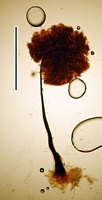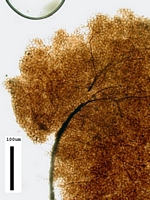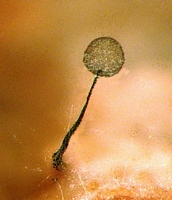|
 Comatricha elegans Comatricha elegans
SynonymsCollaria elegans
Rostafinskia elegans
BiostatusPresent in region - Exotic
Images (click to enlarge)
Caption: scale = 0.5mm.
Owner: J.A. Cooper | 
Caption: spores and capilitium. Note dichotmous branching starts below centre of sporangium.
Owner: J.A. Cooper | 
Caption: combineZ image of fruitbody
Owner: J.A. Cooper |
Article: Stephenson, S.L. (2003). Myxomycetes of New Zealand. Fungi of New Zealand. Ngā Harore o Aotearoa 3: xiv + 238 p. Hong Kong: Fungal Diversity Press.
Description: Fruiting body a stalked sporangium, gregarious to scattered, 1 to 2 mm tall. Sporotheca globose to ovate, erect, purplish or liliaceous brown, 0.3–0.5 mm in diameter. Hypothallus inconspicuous. Stalk slender, subulate, 0.8–1.6 mm long. Peridium silvery, fugacious, rarely persistent. Columella short, divided below the center of the sporotheca (or sometimes at, or occasionally below the base) into several stout branches that give rise to the capillitium. Capillitium rather loose, the threads flexuous, slender, anastomosing. Spores reddish brown or pale to reddish lilac in mass, pale violaceous brown by transmitted light, minutely punctate, 8–10 µm in diameter. Plasmodium watery white.
Habitat: Decaying wood, especially that of conifers.
Distribution: Reported from widely scattered localities in Asia, Europe, North America, and South Africa (Martin & Alexopoulos 1969). First reported from New Zealand by Mitchell (1992), based on a specimen appearing in moist chamber culture prepared with bark of Pinus sp. collected in Taupo/Bay of Plenty.
Notes: This species, which is placed in the genus Comatricha by some authors, is similar morphologically to Comatricha nigra but can be distinguished on the basis of a columella that becomes divided to form several stout branches before reaching the center of the sporotheca. In C. nigra, the columella extends well beyond the center of the sporotheca. Moreover, Collaria elegans tends to be much less common than Comatricha nigra.
|